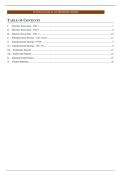TECHNOLOGICAL ENTREPRENEURSHIP
TABLE OF CONTENTS
I. Business Ecosystems – Part 1 .................................................................................................................................. 1
Ii. Business Ecosystems – Part 2 .................................................................................................................................. 6
Iii. Business Ecosystems – Part 3................................................................................................................................. 10
Iv. Entrepreneurial Strategy – Core Assets .................................................................................................................. 16
V. Entrepreneurial Strategy – Ps-Fit ............................................................................................................................. 5
Vi. Entrepreneurial Strategy – Pm - Fit ......................................................................................................................... 9
Vii. Technology Transfer .............................................................................................................................................. 15
Viii. Intellectual Property.............................................................................................................................................. 21
Ix. Entrepreneurial Finance .......................................................................................................................................... 27
X. Product Platforms ................................................................................................................................................... 34
, TECHNOLOGICAL ENTREPRENEURSHIP
I. BUSINESS ECOSYSTEMS – PART 1
1) SECTOR AND INDUSTRIES
1.1.1 Sector
• Primary sector
o Extracts or harvests products from the earth: production of raw material and basic foods.
o Activities: agriculture, mining, forestry, farming, grazing, hunting and gathering, fishing, and quarrying.
+ the packaging and processing of the raw material associated with this sector.
o About 3% of the US labor force is engaged in primary sector activity today, while more than 2/3 of the
labor force were primary sector workers in the mid-nineteenth century.
• Secondary sector
o Manufactures finished goods.
o All of manufacturing, processing, and construction lies within the secondary sector.
o Activities: metal working and smelting, automobile production, textile production, chemical and
engineering industries, aerospace manufacturing, energy utilities, engineering, breweries and bottlers,
constructions, and shipbuilding.
• Tertiary sector
o Service industry.
o Provides services to the general population and to businesses.
o Activities: retail and wholesale sales, transportation and distribution, entertainment, restaurant, clerical
services, media, tourism, insurance, banking, healthcare, and law.
o In the US, more than 80% of the labor force are tertiary workers.
• Quaternary sector
o The quaternary sector consists of intellectual activities.
o Activities: government, culture, libraries, scientific research, education, and information technology.
o Others limit quaternary sector it to not-for-profit sector.
Economic transitions
1.1.2 Industries
• An industry = collection of similar companies or of companies.
• Top-down classification.
• Large sectors gradually split into smaller industries.
• Newcomers and start-ups can use such classification to get an idea of the width of business activities.
• The organism does not care about its classification.
• As companies grow, they can be present in different industries at once.
• Not always straight-forward.
o Ex: Biotech companies
o So, take it as a guide, not as set in stone.
1
, 2) MARKETS
1.1.3 Market definition
• Markets are those meeting places where products and services are traded.
• A trade may involve goods, services, information, currency, or any combination of these that pass from one party
to another.
• They are interfaces in which buyers and sellers can gather and interact.
o Here, rates and prices are determined by supply and demand.
• Its definition is grounded bottom-up.
o Consumers, suppliers (+ consultants and trade show organizer) drive the definition of markets.
o Gradual and ad-hoc classifications, overlaps, not top-down classification of markets.
o Are there magazines, trade fairs, consultants? Then there is a market.
o Partly driven by marketing budgets of suppliers and making-yourself-interesting strategies of industry
specialists (ex: Garner).
• Chicken and the egg: when do you speak of a market?
• They are context dependent.
o Example of context dependent:
▪ The place where securities are traded – the stock market.
▪ A collection of people who wish to buy a specific product or service in a specific place, such as
the Brooklyn housing market.
▪ Maybe represented by physical locations, such as retail stores.
▪ They may be virtual: Internet-based stores and auction sites as Amazon and eBay.
1.1.4 Markets are time-dependent
1.1.4.1 Over time
• Markets merge
o PDA + GSM + iPod + camera + gaming console = iPhone.
o Will PDAs, digital cameras, GSMs, gaming consoles disappear as separate markets?
• Market split
o “Computers” -> hardware, operating system, software, storage, peripherals, internet, …
o Sometimes not (yet) possible (Ex: Quantum computing).
• Markets (dis)appear
o Disappear: analog photography.
o Appear: the graphene market.
• Markets can be encapsulated in others
2




